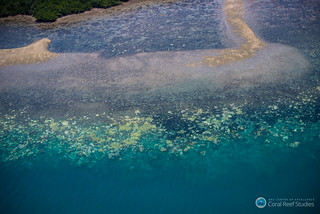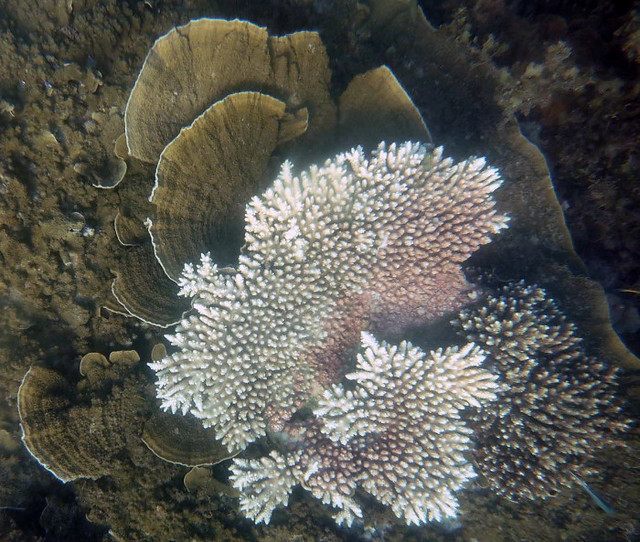科學家前幾日前往大堡礁進行海、空調查證實,世界上規模最大且保存最好的珊瑚礁,正面臨有史以來最嚴重的白化現象。
白化的珊瑚。圖片來源:ARC Centre of Excellence for Coral Reef Studies。
大堡礁珊瑚白化 看不到止境
科學家調查從凱恩斯(Cairns)到巴布亞紐幾內亞(Papua New Guinea)超過500處的珊瑚礁之後,將大多數的珊瑚評為「嚴重白化」。
庫克敦(Cooktown)北方至約克角(Cape York)最北端之間,為珊瑚白化最嚴重的地區;同時,庫克敦到湯斯維爾(Townsville)之間的白化情形也越來越嚴重。
澳洲國家珊瑚白化工作團隊(Australia's National Coral Bleaching Taskforce)召集人休斯(Terry Hughes)說:「這是我這輩子最悲傷的一趟研究之旅。我們飛過去看到的幾乎每處的珊瑚都嚴重白化了,幾乎沒有例外,從礁坡(Reef slope)直到珊瑚礁頂都嚴重白化了。」
「我們飛越大堡礁中狀況最好的4000多公里,結果只看到四處珊瑚沒有白化。這遠遠比先前1998年或2002年的白化危機還嚴重許多。」休斯說。
休斯補充:「更讓人擔憂的是,我們並沒有找到白化的南限。我們未來將在大堡礁的中央附近持續進行空中調查,來確定到底白化的界線在哪裡。」
同樣參與空中調查的澳洲國家珊瑚白化工作組織專案經理凱瑞(James Kerry)說:「我們看到連生命力最旺盛的塊狀珊瑚(massive corals)都有廣泛的白化現象。」
 |
 |
| 從空中俯瞰,白化的珊瑚明顯可見。圖片來源:ARC Centre of Excellence for Coral Reef Studies。 | 從空中俯瞰,白化的珊瑚明顯可見。圖片來源:ARC Centre of Excellence for Coral Reef Studies。 |
高溫逆境 珊瑚的夏天很難熬
南半球的夏天將要接近尾聲,而這個夏天已經摧毀大堡礁北部的珊瑚;在南邊,因為多雲的天氣使水溫下降,讓南部的大堡礁幸運的「逃過一劫」。
「連這些頑強的物種都變白,就可以知道這個夏天的情況對北部的大堡礁來說有多艱困。」凱瑞說,「我們在約克角與當地居民談話,而這些居民被眼前所見震懾,他們表示以前從來沒有看過這種現象。」
當珊瑚周遭溫度過高時就會發生珊瑚白化的現象。不停升高的海水溫度,使珊瑚的共生藻——光合微藻(又稱蟲黃藻,zooxanthellae)——的數量開始減少。這些藻類提供食物給其宿主珊瑚,藉此換取棲身之地。失去這些五顏六色的藻類,即為珊瑚白化的原因。
如果水溫快速恢復正常,蟲黃藻有機會回到珊瑚中,但如果水溫沒有下降,珊瑚終將死亡。
珊瑚礁科學家說,3月時部份的珊瑚礁地區雲量多且下雨,但這仍無法讓海水溫度下降到足以緩解高溫逆境(heat stress)的程度。北部約1/3的珊瑚礁處於嚴重的高溫逆境中,海水水溫約高於平均1°C~2°C;中部的珊瑚礁約比平均值高1°C;南部則高出0.5°C~1°C。
「科學家在水底下已經發現白化的珊湖有將近50%的死亡率,但現階段談論整體的影響依然言之過早。我們會在接下來的幾個月持續在大堡礁進行水下調查,來了解大量白化現象所造成的影響。」休斯說。
科學家進行海底調查,記錄珊瑚白化狀況。圖片來源:ARC Centre of Excellence for Coral Reef Studies。
籲強化氣候變遷政策 環團:澳總理應親眼看看白化慘狀
本月5日,300名珊瑚礁研究人員出動研究船,要跟時間賽跑,在大堡礁北部約1000公里內嚴重白化的珊瑚死亡之前,記錄珊瑚白化的狀況。
ARC珊瑚礁卓越研究中心(ARC Centre of Excellence for Coral Reef Studies)的普萊契(Morgan Pratchett)說:「到目前為止我們一共用研究船進行了12個不同的任務,這個月底之前我們將會調查近90處的珊瑚礁,同時也會從空中進行調查。」
「不幸的是,水下調查的結果同樣顯示從凱恩斯到托雷斯海峽(Torres Strait)的珊瑚白化狀況都非常嚴重。上星期我們的潛水研究人員發現道格拉斯港(Port Douglas)有75%的珊瑚都白化了,凱恩斯則有將近50%,還好凱恩斯南邊只有10%至30%。」
世界自然基金會澳洲分會(WWF-Australia)力勸澳洲總理騰博(Malcolm Turnbull)親自到大堡礁一趟看看這些慘況,並展現出政府對抗氣候變遷的決心。
世界自然基金會澳洲分會的總裁歐格曼(Dermot O'Gorman)說:「不論是澳洲或是世界上的任何地方,政府不能繼續對氣候變遷感到自滿。如果我們不趕快開始採取行動,大堡礁將會消失。」
總理辦公室則表示,騰博目前沒有計畫前往大堡礁。
澳洲環境部長杭特(Greg Hunt)則說:「考慮到目前的白化情形,澳洲政府將在9月提供研究船與重新進行資料調查分析所需的資金,藉此來重新調查40處2012年調查過的北部珊瑚礁,其中30處在2014年伊塔颶風(Tropical Cyclone Ita)來襲後有再次調查過。」
大堡礁一處珊瑚出現白化現象,旁邊則是尚未白化的珊瑚。攝影:Andrew Baird。圖片來源:ARC Centre of Excellence for Coral Reef Studies。
大堡礁國家公園:白化程度提升至最高級
澳洲政府和昆士蘭政府為未來的幾十年的保護大堡礁計劃,投資了澳幣約20億(約新台幣487億)。
澳洲國家珊瑚白化工作團隊召集了整個澳洲和美國10個研究中心,共有超過300位科學家參與。合作的研究機構包含ARC珊瑚礁卓越研究中心、澳洲海洋科學研究所(Australian Institute of Marine Science)、澳洲科學與工業研究組織(CSIRO)、大堡礁海洋公園管理局(Great Barrier Reef Marine Park Authority),以及多所大學院校;美國方面則有美國國家海洋暨大氣總署(NOAA)參與。
回應最早的研究結果,大堡礁海洋公園管理局將大堡礁受威脅的程度提高到第三級「嚴重區域白化」,這是珊瑚白化威脅的最高層級。
大堡礁海洋公園管理局局長雷徹爾特(Russell Reichelt)說:「第三級的威脅表示我們要增加對大堡礁中死亡珊瑚的調查,以幫助我們理解到底這些種種不利因素對大堡礁造成了什麼影響,協助我們確定下一步該怎麼做。」
雷徹爾特說:「做法像是減少排入流域中的肥料養分或沉積物,以此來控制會吃珊瑚蟲的棘冠海星(crown of thorns starfish)數量,還有成為國際上為減少排碳量努力的一員。」
他解釋,白化現象依然在持續當中,詳細的範圍和嚴重程度仍然需要幾週的時間才會明朗。至於整個大堡礁的評估與調查也需要好幾週才能完成。
The most pristine section of the world largest coral reef is experiencing the worst mass bleaching event in history, scientists have determined during aerial and in-water surveys of the Great Barrier Reef.
After surveying more than 500 coral reefs from Cairns, Australia to Papua New Guinea, scientists rank the overwhelming majority of reefs in the most severe bleaching category.
The most severe bleaching is in the far northern sector between Cooktown and the tip of Cape York. Bleaching has also intensified in the area between Cooktown and Townsville.
Research conducted by multiple research vessels and island research stations confirms what is visible from the air, that the majority of reefs north of Cairns are bleached out. All species of corals are being affected.
“This has been the saddest research trip of my life,” said Professor Terry Hughes, convenor of Australia’s National Coral Bleaching Taskforce. “Almost without exception, every reef we flew across showed consistently high levels of bleaching, from the reef slope right up onto the top of the reef.”
“We flew for 4,000 kilometers in the most pristine parts of the Great Barrier Reef and saw only four reefs that had no bleaching,” said Hughes. “The severity is much greater than in earlier bleaching events in 2002 or 1998.”
“Even more concerning, we haven’t yet found the southern limit of the bleaching,” Hughes said. “We’ll be conducting further aerial surveys this week in the central Great Barrier Reef to identify where it stops.
He said the southern part of the Great Barrier Reef “dodged a bullet” due to cloudy weather that cooled the water temperatures.
“We could see extensive bleaching even among the most robust massive corals,” said James Kerry, project manager of the National Coral Bleaching Taskforce, who participated in the aerial surveys.
Summer in the Southern Hemisphere is just coming to a close, and this summer has been devastating for the corals on the Great Barrier Reef’s northern section.
“The fact that these hardy species have also turned white shows just how severe summer conditions have become on the northern Great Barrier Reef,” Kerry said.
“Residents we spoke to in Cape York were shocked by what they are seeing, telling us that they had never experienced anything like this before,” he said.
Coral bleaching occurs when live corals are stressed from overheating. Heightened sea temperatures cause them to expel tiny photosynthetic algae, called zooxanthellae found in healthy corals. The algae provide their host coral with food in return for protection. The loss of these colorful algae causes the corals to turn white.
If the waters cool down quickly, the zooxanthellae can recolonize them, but if the corals remain stressed for many weeks, they will die.
Reef scientists say that there was substantial cloud cover and rain over parts of the reef in March, but this did not have a sufficient cooling effect on sea temperatures to relieve heat stress.
“Scientists in the water are already reporting up to 50 percent mortality of bleached corals,” said Hughes, “but it’s still too early to tell just what the overall outcome will be. We will continue to conduct underwater surveys along the Great Barrier Reef in the coming months as the full impact of this mass bleaching event unfolds.”
On Tuesday, after months of planning, 300 Australian coral reef researchers launched a small flotilla of research vessels. Their mission is a race against time – to document coral bleaching along the 1000 kilometer northern half of the Great Barrier Reef before more of the heavily bleached corals die.
“So far we have collectively undertaken 12 separate missions using research vessels, and by the end of this month we will have examined close to 90 reefs that have also been surveyed from the air,” says Professor Morgan Pratchett from the ARC Centre of Excellence for Coral Reef Studies.
“Unfortunately, our underwater surveys are also revealing very high levels of bleaching from Cairns to Torres Straits. Last week, our research divers found that 75 percent of the corals were bleached on multiple reefs near Port Douglas, and nearly 50 percent near Cairns. South of Cairns, thankfully, has closer to 10-30 percent bleaching.”
The nonprofit conservation group WWF-Australia is urging Prime Minister Malcolm Turnbull to travel to the Great Barrier Reef to see the damage firsthand and to show government leadership on climate change.
“The Australian government has said in the past that the reef’s World Heritage values are safe. But if there are mass coral deaths from this event, what does that mean for the reef’s ongoing World Heritage status?” asked Dermot O’Gorman, CEO of WWF-Australia.
Whether in Australia or elsewhere around the world, “governments cannot continue complacency on climate change,” said O’Gorman. “If we don’t start to see some real leadership on the reef, it will be gone.”
The Prime Minister’s office has announced no plans for Turnbull to visit the Great Barrier Reef,.
But Environment Minister Greg Hunt says that in view of the current bleaching event, in September the Australian government will provide a research vessel and cover costs of data analysis to re-survey 40 sites in the Far Northern section of the reef surveyed in 2012 and 30 of the same sites again surveyed in 2014 after Tropical Cyclone Ita.
The Australian and Queensland governments are investing a projected A$2 billion over the next decade to protect the Great Barrier Reef.
The National Coral Bleaching Taskforce co-ordinates the research efforts of Australia’s marine science community in the event of a mass bleaching event. The taskforce gathers 10 research institutions and over 300 scientists across Australia and the United States.
The associated research institutions are ARC Centre of Centre of Excellence for Coral Reef Studies, Australian Institute of Marine Science, CSIRO, Great Barrier Reef Marine Park Authority, James Cook University, the University of Queensland, University of Sydney, University of Western Australia, and Western Australia’s Department of Parks and Wildlife. In the United States, NOAA, the National Oceanic and Atmospheric Administration is a participant.
In response to the initial survey findings, the Great Barrier Reef Marine Park Authority, GBRMPA, has upgraded its alert system to level three, severe regional bleaching, the highest category in its coral bleaching response plan.
“A level three response level means we’re stepping up surveys in response to the coral mortality to help us better understand the effects of various pressures on the Reef and help guide management actions,” said Great Barrier Reef Marine Park Authority Chairman Dr. Russell Reichelt.
“This means reducing nutrient and sediment loads in catchment run-off, continuing our program to control coral-eating crown of thorns starfish and being part of a global compact to reduce overall emissions,” Dr. Reichelt said.
The bleaching event is still unfolding, he explained, and the full extent and severity of bleaching may take several weeks to become clear. Reef-wide assessments and analyses of bleaching will take several weeks to complete.
The northern third of the reef is experiencing the most heat stress, with recorded sea surface temperatures of 1-2 degree Celsius above average.
The central part of the reef is generally about one degree Celsius above average, while temperatures in the southern part are about 0.5-1 degree Celsius warmer than average.
※ 全文及圖片詳見:ENS










